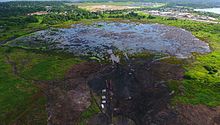Pitch Lake

The Pitch Lake is the largest natural deposit of
Pitch Lake is a popular tourist attraction, including a small museum, from where official tour guides can escort people across the lake. The lake is mined for asphalt by Lake Asphalt of Trinidad and Tobago.
History


The Pitch Lake has fascinated explorers and scientists, attracting tourists since its re-discovery by Sir
In the 1840s, Abraham Pineo Gesner first obtained kerosene from a sample of Pitch Lake bitumen.[5]
In 1887,
Since its re-discovery, there have been numerous research investigations into the use and chemical composition of this material. There have been countless theories, postulations, and conclusions as to the size, source, and origin of the asphalt.[citation needed]
Geology

The origin of The Pitch Lake is related to deep
The regional geology of southern Trinidad consists of a trend of
The first wells were drilled into Pitch Lake
Microbiology
Evidence of an active microbiological ecosystem in Pitch Lake has been reported. The microbial diversity was found to be unique when compared to microbial communities analyzed at other hydrocarbon-rich environments, including La Brea tar pits in California, and an oil well and a mud volcano in Trinidad and Tobago.[11] Archaeal and bacterial communities co-exist, with novel species having been discovered from Pitch Lake samples.[8] Researchers have also observed novel fungal life forms which can grow on the available asphaltenes as a sole carbon and energy source.[12]
See also
References
- ^ "The Pitch Lake". National Museums Liverpool. Archived from the original on 2018-10-01. Retrieved 2018-03-19.
- ^ "Trinidad Express Newspapers: | La Brea, home of the pitch lake". 2018-02-16. Archived from the original on 2018-02-16. Retrieved 2019-02-19.
- ^ "La Brea, Pitch Lake," UNESCO World Heritage Centre, August 2011, accessed September 28, 2018, https://whc.unesco.org/en/tentativelists/5645/.
- ^ Brock, Fiona, Joanna Ostapkowicz, Alex C. Wiedenhoeft, and Ian D. Bull. "Radiocarbon Dating Wooden Carvings and Skeletal Remains from Pitch Lake, Trinidad." Radiocarbon 59, no. 05 (October 2017): 1447-461. Accessed September 26, 2018. doi:10.1017/rdc.2017.78.
- ^ Gesner, Abraham (1861). "A Practical Treatise of Coal, Petroleum, and Other Distilled Oils". Internet Archive. Bailliere Brothers. pp. 26–28. Retrieved 27 June 2020.
- ^ Daniel Smith Lamb, Historical, Biographical and Statistical Souvenir (Washington: Beresford: Howard University Medical Department, 1900), 86.
- ^ "A Gravity Investigation of the Pitch Lake Of Trinidad And Tobago". Geological Society of Trinidad & Tobago. Archived from the original on 2010-01-31. Retrieved 2008-05-27.
- ^ S2CID 22078593.
- ^ Microbial Life Found in Hydrocarbon Lake. the physics arXiv blog 15 April 2010.
- ^ a b Woodside, P.R., The Petroleum Geology of Trinidad and Tobago, 1981, USGS Report 81-660, Washington: US Dept. of the Interior, pp. 10
- S2CID 22078593.
- PMID 21624102.
External links
- Seaman, Richard. "Trinidad's Pitch Lake". The Flying Kiwi. Retrieved 2020-03-03.
- Grossman, Lisa (2010-04-23). "Life in the sticky lane". Science News. Archived from the original on 2010-04-27.
